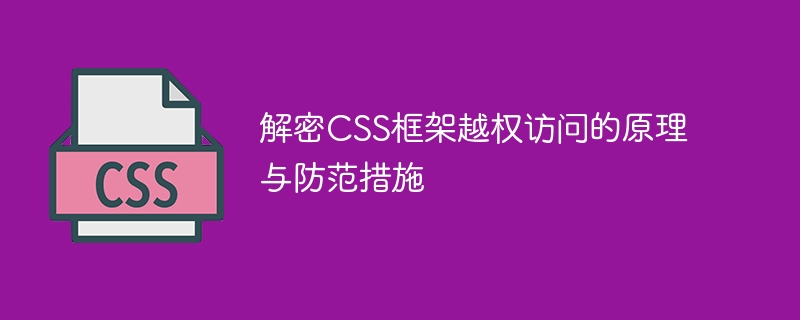

Decrypt the principles and preventive measures of unauthorized access to CSS framework
With the rapid development of the Internet, web design has gradually become an important technology. In order to improve efficiency and unify styles, many developers use CSS frameworks to quickly build web pages. However, some criminals exploit vulnerabilities in the CSS framework to perform unauthorized access, causing serious security risks. This article will decipher the principles of CSS framework unauthorized access and provide some preventive measures to protect website security.
The CSS framework is a pre-written style library that can be used to define the layout, fonts, colors and other styles of web pages. Common CSS frameworks include Bootstrap, Foundation, Semantic UI, etc. These frameworks usually have open source code and are widely used on various websites.
But precisely because of the widespread application of the CSS framework, it also gives attackers the opportunity to access without authority. Attackers can abuse the functionality of CSS frameworks to tamper with page content, escalate privileges, or execute malicious code.
A common method of unauthorized access is to exploit file inclusion vulnerabilities in CSS frameworks. Suppose a website uses a CSS framework that contains user-defined styles. An attacker could forge a style file and load it onto a website using a file inclusion vulnerability. Once an attacker's style file loads successfully, they can execute arbitrary code on the page, change the site's layout, or steal user information.
Another method of unauthorized access is to achieve by changing the style definition of the CSS framework. In the CSS framework, developers can use the @import rule to introduce external style sheets. Attackers can introduce malicious code into the website by tampering with these style sheets. Once the malicious code takes effect, the attacker can steal sensitive user information or perform other harmful operations.
To prevent unauthorized access to the CSS framework, we have the following suggestions:
In general, to protect websites from the risk of unauthorized access by CSS frameworks, developers need to increase their security awareness of CSS frameworks and take appropriate preventive measures. Only by improving security awareness and responding to vulnerabilities in a timely manner can the security of the website be ensured.
The above is the detailed content of Decrypt the principles and preventive measures of unauthorized access to CSS frameworks. For more information, please follow other related articles on the PHP Chinese website!
 What is the difference between css framework and component library
What is the difference between css framework and component library
 What data does redis cache generally store?
What data does redis cache generally store?
 How to buy Dogecoin
How to buy Dogecoin
 What are the Chinese programming languages?
What are the Chinese programming languages?
 How to delete a directory in LINUX
How to delete a directory in LINUX
 How to turn off ics network sharing
How to turn off ics network sharing
 Regular expression does not contain
Regular expression does not contain
 What should I do if the print spooler cannot be started?
What should I do if the print spooler cannot be started?




